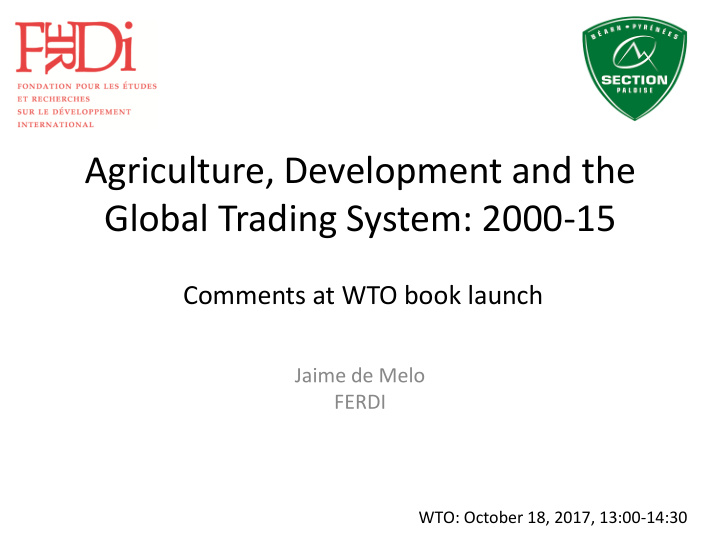



Agriculture, Development and the Global Trading System: 2000-15 Comments at WTO book launch Jaime de Melo FERDI WTO: October 18, 2017, 13:00-14:30
Summary Excellent impressive evidence-based work grounded in reality. Recognition of: • Complexity of protection: for farm lobbies (= subsidies) vs. food security for consumers (=export taxes). Sen (1981) • Complexity of global trading system (Multilateral, regional preferential and non-preferential). EGA stall • Judicious use of CGE toolkit (this is a GE problem …) • Nice twist of recognizing political economy dimension of rent-transfer implications of policies (Nash bargaining vs. Nash non-cooperative solution) • Next slides: More on Political economy; NTMs; and thoughts for Antoine’s and David’s next opus
More on Political Economy Extended lobbyin à la G- H ‘Protection for sale’ provides insight on pattern of protection in an archetype rich-poor setting • Protection rises with the degree of processing for ag. and industry • Protection is higher in developing economies • Agriculture relatively more protected (than agriculture) in industrial countries (fig. 1 below) Simulations with factor market rivalry and IO linkages endogenously reproduce insight of Anderson (1995) --Support to rich farmers in industrial countries raises their incomes substantially while marginally reducing incomes of manufacturing industrialists --- Agricultural taxation in poor countries reduces farmers ’ income marginally and raises incomes of capitalists and workers substantially.
NTMs: Beyond AVEs • Difficult to get plausible AVEs from estimation of trade flows at HS-6 level with CR and FI. More plausible estimates on agriculture NTMs Murina and Nicita (2017): Careful selection of EU SPS measures. Slightly positive correlation between imports for each one of 21 Ag. Sectors and regulatory intensity Bilateral estimates show that higher regulatory intensity correlates with lower level of trade originating from low-income countries Xiong and Beghin (2105) investigate MRL regulations to disentangle effects on import demand and on foreigners’s supply. : MRLs jointly enhance import demand and hinder foreign exporters ’ supply ….and exporters from LDCs are more constrained by MRLs than their developed-world competitors
Looking Ahead: climate change challenge Concluding thoughts for Antoine’s and David’s next opus ! • SSA has contributed least to climate change so far and will suffer the most according to projections by 2050 with strong migration implications (next slide) • Sahel is on the edge of poverty traps (last 2 slides) Fertile ground for CGE modelling introducing climate and migration
CO2 emissions vs. Population shares (regional averages) • Bubbles proportional to total CO2 emissions (cement and fossil fuels). • Regions below the 45 line have below- average per capita emissions. • If converging CO2 emissions per capita, effort from North America, Europe and East Asia Projected damages by region (in 2050) Strongest damages in SSA and SA (above population shares) In absence of migration large redistribution of population across regions Strong migratory pressures is SA, SSA, EA if adaptation fails
On the edge of poverty traps (1) Share of rural population on fragile isolated lands ( ▪ ), Low-level coastal lands ( ), high infant mortality risk ( ● ) high malnutrition ( ♦ ) ( regional averages ) Source: Corneille, A. and J. de Melo (2016)
On the edge of poverty traps (2) Gross and Net Savings (adjusted for depreciation of natural capital) Size of bubbles proportional to population growth versus population growth (Regional averages 2000-13) Source: Corneille, A. and J. de Melo (2016) Over 2000-13, SSA savings barely sufficient to maintain current generation level of income !
References Anderson, K. (1995) «Lobbying and the Pattern of Protection in Rich and Poor Countries», EDCC, 43(2) Bouet, A. (2012) «Le grand malentendu: L’idée de libre échange en France» ( great stuff !) Cadot, Melo, and Olarreaga (2004) «Lobbying, Counter-lobbying and the Structure of tariff Protection» , WBER, 18(3) Corneille, A. and Melo (2016) «Quelques Défis de l’Afrique sub -saharienne face au changement climatique», Brève #165, FERDI http://www.ferdi.fr/fr/publication/b165- quelques-d%C3%A9fis-de-l%E2%80%99afrique-sub-saharienne-face-au-changement- climatique Murina M and Nicita A (2017). Trading with conditions: the effect of sanitary and phytosanitary measures on the agricultural exports from low-income countries. The World Economy . 40(1):168 – 181. Sen, A. (1981) Poverty and Famines: An Essay on Entitlement and Deprivation , Oxford Press Xiong B and Beghin J (2014). “Disentangling demand-enhancing and trade-cost effects of maximum residue regulations” Economic Inquiry . 52(3):1190-1203.
Recommend
More recommend